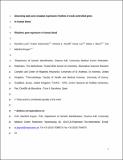Files in this item
Dissecting daily and circadian expression rhythms of clock-controlled genes in human blood
Item metadata
| dc.contributor.author | Lech, Karolina | |
| dc.contributor.author | Ackermann, Katrin | |
| dc.contributor.author | Revell, Victoria L. | |
| dc.contributor.author | Lao, Oscar | |
| dc.contributor.author | Skene, Debra J. | |
| dc.contributor.author | Kayser, Manfred | |
| dc.date.accessioned | 2016-03-18T13:30:06Z | |
| dc.date.available | 2016-03-18T13:30:06Z | |
| dc.date.issued | 2016-02-01 | |
| dc.identifier | 240592822 | |
| dc.identifier | a8bbe0a7-839e-487f-8ade-0c7d110c74d9 | |
| dc.identifier | 84954099603 | |
| dc.identifier | 000368166500007 | |
| dc.identifier.citation | Lech , K , Ackermann , K , Revell , V L , Lao , O , Skene , D J & Kayser , M 2016 , ' Dissecting daily and circadian expression rhythms of clock-controlled genes in human blood ' , Journal of Biological Rhythms , vol. 31 , no. 1 , pp. 68-81 . https://doi.org/10.1177/0748730415611761 | en |
| dc.identifier.issn | 0748-7304 | |
| dc.identifier.uri | https://hdl.handle.net/10023/8436 | |
| dc.description | This study was supported in part by the Netherlands Organization for Scientific Research (NWO) Forensic Science Program Grant 27.011.001, the European Union 6th Framework project EUCLOCK (018741), the UK Biotechnology and Biological Sciences Research Council (BBSRC) grant BB/I019405/1, and Erasmus MC University Medical Center Rotterdam. D.J.S. is a Royal Society Wolfson Research Merit Award holder. | en |
| dc.description.abstract | The identification and investigation of novel clock-controlled genes (CCGs) has been conducted thus far mainly in model organisms such as nocturnal rodents, with limited information in humans. Here, we aimed to characterize daily and circadian expression rhythms of CCGs in human peripheral blood during a sleep/sleep deprivation (S/SD) study and a constant routine (CR) study. Blood expression levels of 9 candidate CCGs (SREBF1, TRIB1, USF1, THRA1, SIRT1, STAT3, CAPRIN1, MKNK2, and ROCK2), were measured across 48 h in 12 participants in the S/SD study and across 33 h in 12 participants in the CR study. Statistically significant rhythms in expression were observed for STAT3, SREBF1, TRIB1, and THRA1 in samples from both the S/SD and the CR studies, indicating that their rhythmicity is driven by the endogenous clock. The MKNK2 gene was significantly rhythmic in the S/SD but not the CR study, which implies its exogenously driven rhythmic expression. In addition, we confirmed the circadian expression of PER1, PER3, and REV-ERBα in the CR study samples, while BMAL1 and HSPA1B were not significantly rhythmic in the CR samples; all 5 genes previously showed significant expression in the S/SD study samples. Overall, our results demonstrate that rhythmic expression patterns of clock and selected clock-controlled genes in human blood cells are in part determined by exogenous factors (sleep and fasting state) and in part by the endogenous circadian timing system. Knowledge of the exogenous and endogenous regulation of gene expression rhythms is needed prior to the selection of potential candidate marker genes for future applications in medical and forensic settings. | |
| dc.format.extent | 14 | |
| dc.format.extent | 906111 | |
| dc.language.iso | eng | |
| dc.relation.ispartof | Journal of Biological Rhythms | en |
| dc.subject | Sleep deprivation | en |
| dc.subject | Constant routine | en |
| dc.subject | Gene expression | en |
| dc.subject | Human blood | en |
| dc.subject | Clock-controlled genes | en |
| dc.subject | QD Chemistry | en |
| dc.subject | QH426 Genetics | en |
| dc.subject | Physiology | en |
| dc.subject | Physiology (medical) | en |
| dc.subject | NDAS | en |
| dc.subject.lcc | QD | en |
| dc.subject.lcc | QH426 | en |
| dc.title | Dissecting daily and circadian expression rhythms of clock-controlled genes in human blood | en |
| dc.type | Journal article | en |
| dc.contributor.institution | University of St Andrews. School of Chemistry | en |
| dc.identifier.doi | 10.1177/0748730415611761 | |
| dc.description.status | Peer reviewed | en |
| dc.identifier.url | http://jbr.sagepub.com/content/31/1/68/suppl/DC1 | en |
This item appears in the following Collection(s)
Items in the St Andrews Research Repository are protected by copyright, with all rights reserved, unless otherwise indicated.

